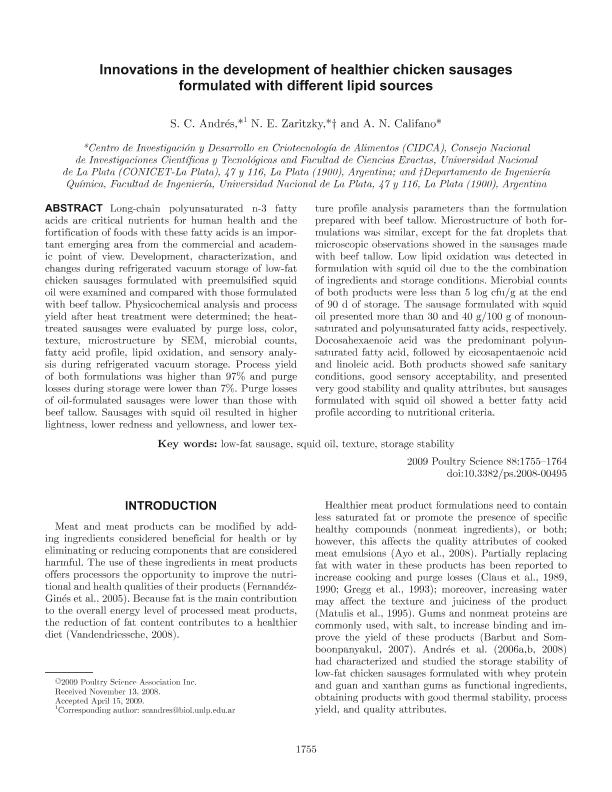Mostrar el registro sencillo del ítem
dc.contributor.author
Andres, Silvina Cecilia

dc.contributor.author
Zaritzky, Noemi Elisabet

dc.contributor.author
Califano, Alicia Noemi

dc.date.available
2022-06-23T03:23:27Z
dc.date.issued
2009-08
dc.identifier.citation
Andres, Silvina Cecilia; Zaritzky, Noemi Elisabet; Califano, Alicia Noemi; Innovations in the development of healthier chicken sausages formulated with different lipid sources; Poultry Science Association; Poultry Science; 88; 8; 8-2009; 1755-1764
dc.identifier.issn
0032-5791
dc.identifier.uri
http://hdl.handle.net/11336/160284
dc.description.abstract
Long chain polyunsaturated n-3 fatty acids (PUFA) are critical nutrients for human health and the fortification of foods with these fatty acids is an important emerging area from the commercial and academic point of view. Development, characterization and changes during refrigerated vacuum storage of low-fat chicken sausages formulated with pre-emulsified squid oil were examined and compared to those formulated with beef tallow. Physico chemical analysis and process yield after heat treatment were determined; the heat treated sausages were evaluated by purge loss, color, texture, microstructure by SEM, microbial counts, fatty acid profile, lipid oxidation and sensory analysis during refrigerated vacuum storage. Process yield of both formulations were higher than 97% and purge losses during storage lower than 7%. Purge losses of oil formulated sausages were lower than those with beef tallow. Sausages with squid oil resulted in higher lightness, lower redness and yellowness, and lower Texture Profile Analysis parameters than the formulation prepared with beef tallow. Microstructure of both formulations were similar, except for the fat droplets that microscopic observations showed in the sausages made with beef tallow. Low lipid oxidation was detected in formulation with squid oil due to the the combination of ingredients and storage conditions. Microbial counts of both products were less than 5 log CFU/g at the end of 90 days of storage. The sausage formulated with squid oil presented more than 30 and 40 g/100 g of monounsaturated and polyunsaturated fatty acids, respectively. Docosahexaenoic acid was the predominant polyunsaturated fatty acid, followed by eicosapentaenoic acid and linoleic acid. Both products showed safe sanitary conditions, good sensory acceptability and presented very good stability and quality attributes but sausages formulated with squid oil showed a better fatty acid profile according to nutritional criteria.
dc.format
application/pdf
dc.language.iso
eng
dc.publisher
Poultry Science Association

dc.rights
info:eu-repo/semantics/openAccess
dc.rights.uri
https://creativecommons.org/licenses/by-nc-sa/2.5/ar/
dc.subject
LOW-FAT SAUSAGE
dc.subject
SQUID OIL
dc.subject
STORAGE STABILITY
dc.subject
TEXTURE
dc.subject.classification
Otras Ingeniería Química

dc.subject.classification
Ingeniería Química

dc.subject.classification
INGENIERÍAS Y TECNOLOGÍAS

dc.title
Innovations in the development of healthier chicken sausages formulated with different lipid sources
dc.type
info:eu-repo/semantics/article
dc.type
info:ar-repo/semantics/artículo
dc.type
info:eu-repo/semantics/publishedVersion
dc.date.updated
2022-06-13T15:45:37Z
dc.journal.volume
88
dc.journal.number
8
dc.journal.pagination
1755-1764
dc.journal.pais
Estados Unidos

dc.journal.ciudad
STANFORD ,USA
dc.description.fil
Fil: Andres, Silvina Cecilia. Provincia de Buenos Aires. Gobernación. Comisión de Investigaciones Científicas. Centro de Investigación y Desarrollo en Criotecnología de Alimentos. Consejo Nacional de Investigaciones Científicas y Técnicas. Centro Científico Tecnológico Conicet - La Plata. Centro de Investigación y Desarrollo en Criotecnología de Alimentos. Universidad Nacional de La Plata. Facultad de Ciencias Exactas. Centro de Investigación y Desarrollo en Criotecnología de Alimentos; Argentina
dc.description.fil
Fil: Zaritzky, Noemi Elisabet. Provincia de Buenos Aires. Gobernación. Comisión de Investigaciones Científicas. Centro de Investigación y Desarrollo en Criotecnología de Alimentos. Consejo Nacional de Investigaciones Científicas y Técnicas. Centro Científico Tecnológico Conicet - La Plata. Centro de Investigación y Desarrollo en Criotecnología de Alimentos. Universidad Nacional de La Plata. Facultad de Ciencias Exactas. Centro de Investigación y Desarrollo en Criotecnología de Alimentos; Argentina. Universidad Nacional de La Plata. Facultad de Ingeniería. Departamento de Ingeniería Química; Argentina
dc.description.fil
Fil: Califano, Alicia Noemi. Provincia de Buenos Aires. Gobernación. Comisión de Investigaciones Científicas. Centro de Investigación y Desarrollo en Criotecnología de Alimentos. Consejo Nacional de Investigaciones Científicas y Técnicas. Centro Científico Tecnológico Conicet - La Plata. Centro de Investigación y Desarrollo en Criotecnología de Alimentos. Universidad Nacional de La Plata. Facultad de Ciencias Exactas. Centro de Investigación y Desarrollo en Criotecnología de Alimentos; Argentina
dc.journal.title
Poultry Science

dc.relation.alternativeid
info:eu-repo/semantics/altIdentifier/doi/http://dx.doi.org/10.3382/ps.2008-00495
dc.relation.alternativeid
info:eu-repo/semantics/altIdentifier/url/https://www.sciencedirect.com/science/article/pii/S0032579119389825
Archivos asociados
